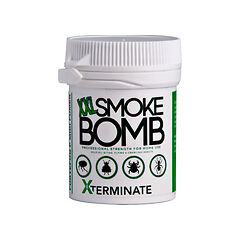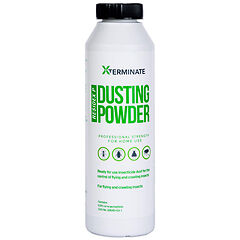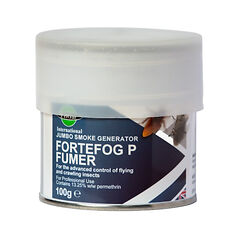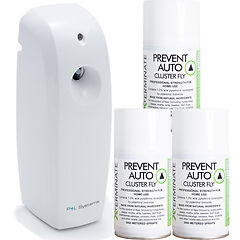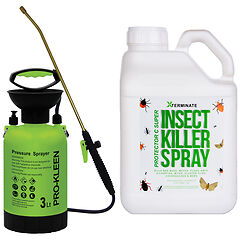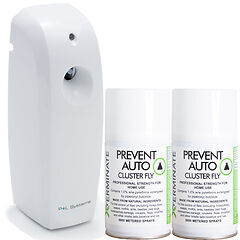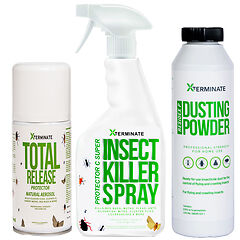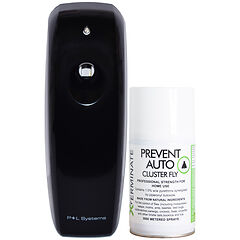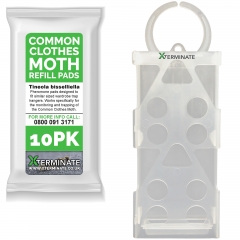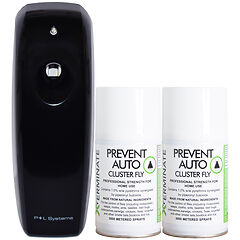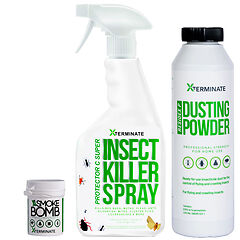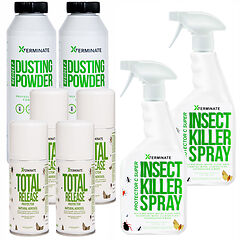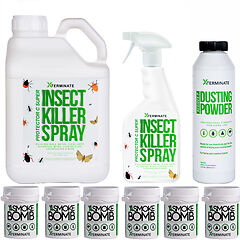Moths
Carpet moths and clothes moths are an increasingly common problem across the UK. They can destroy your valuable clothes, rugs, upholstery, and more with ease - we'll show you how to get rid of them and prevent them from returning!
Carpet Moths and Clothes Moths
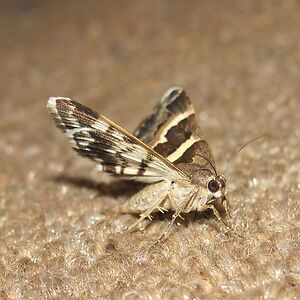 Moths are one of the most common pests in the UK. They’ve been chewing through our best clothes and carpets for centuries, and they aren’t going away anytime soon. If you’ve noticed your best fabrics looking a little, well, moth-eaten lately, there’s a good chance they actually are! Our guide will help you identify and, more importantly, treat your moth problem properly.
Moths are one of the most common pests in the UK. They’ve been chewing through our best clothes and carpets for centuries, and they aren’t going away anytime soon. If you’ve noticed your best fabrics looking a little, well, moth-eaten lately, there’s a good chance they actually are! Our guide will help you identify and, more importantly, treat your moth problem properly.
Moth Larvae
As with many insects, it’s not actually the adult moths that cause the damage; it’s the young moth larvae that chew through your clothes. A moth starts life as a tiny caterpillar which grows as it feeds. They eat a protein called keratin which is found in nearly every natural material including wood, paper, silk, cotton, wool, hair, feathers, and more. What this means is that these caterpillars aren’t picky eaters – they’ll chew through almost anything to get a meal!
Clothes Moths, Carpet Moths, and Carpet Beetles
If you notice that holes have started appearing in your clothes or carpets, your first thought will probably be that you have a moth problem. However, this isn’t always the case. Carpet beetles are now every bit as common as moths, but they require slightly different treatment, so it’s a good idea to determine which pest it is you’re dealing with before you buy a load of pest control products.
As with moths, it’s the caterpillar-like larvae of the carpet beetle which cause damage. The two are easy to confuse, but there are a few differences between them. Moth caterpillars are longer and are usually lighter-coloured than the dark brown carpet beetle larvae. Carpet moth and clothes moth caterpillars are usually hairless, while carpet beetle larvae are covered in brownish bristles. The most obvious difference between the two is that moth caterpillars will usually (but not always) spin themselves a silk “feeding tunnel” which they poke their heads out of to feed, meaning they should be easy to recognise.
Unfortunately, laying eyes on these tiny grubs is easier said than done unless you’re specifically looking for them. Usually, you’ll notice the holes that will appear in your clothes and carpets before you notice the caterpillars themselves. Examining the damage will give you a clue as to which pest you’re dealing with. If you find the holes are spread around your fabric in a random pattern, that’s a sign you’re dealing with moths. If you notice the holes are all grouped together around one particular area of the fabric or that the threads have been eaten away along seams, you’re looking at a carpet beetle problem. Check here to learn more about dealing with carpet beetle infestations.
The Difference Between Carpet Moths and Clothes Moths
While carpet moths and clothes moths aren’t the same species, in practical terms there is very little difference between them. Neither is particularly picky about what they eat so you can find carpet moth caterpillars in your clothes and vice versa. This means you should focus on the area you’re treating rather than worrying about what particular type of moth you’re dealing with. If you’re treating sensitive fabrics, use a more sensitive pest control product such as mothballs.
Treating a Moth Problem
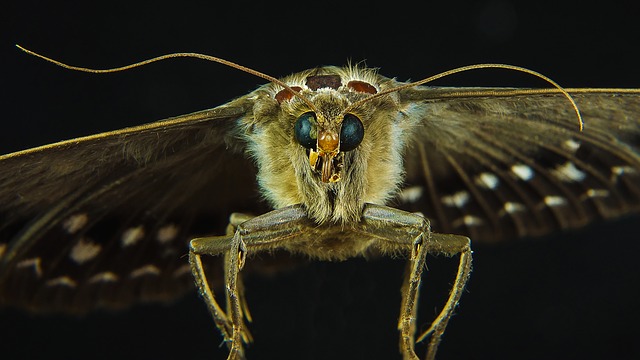 If you’ve confirmed that you are dealing with moths, you’ll want to get rid of them as quickly as possible. Luckily, there is a wide range of products that you can use to treat even severe moth infestations. As with any pest infestation, the best approach is to use multiple products at once to ensure you mop up every last moth.
If you’ve confirmed that you are dealing with moths, you’ll want to get rid of them as quickly as possible. Luckily, there is a wide range of products that you can use to treat even severe moth infestations. As with any pest infestation, the best approach is to use multiple products at once to ensure you mop up every last moth.
Protector FCIK Aerosol Spray
While adult moths don’t actually cause any damage, the eggs they lay eventually will. That’s why it’s important to get rid of them as soon as you spot them fluttering about! Protector FCIK spray will do just that – it’s great for using as a targeted spray that will quickly knock down and kill moths. The spray contains a mix of natural and synthetic pesticides which attack the moth’s brains after they breathe it in. This means it works as a space spray, too so you can use it to take down small groups of moths as they fly around. As an added bonus, FCIK works on pretty much every other kind of insect, so it’s always good to have a can around the house!
Moth Balls and Hanging Moth Proofers
 Moth balls have been around for decades for one simple reason – they really work! Moths are attracted to the smell of cosmetic products like perfumes, makeup, and hair gel. Moth balls let you use this fact to your advantage – they’re perfumed balls that are soaked in an insecticide. Place a few of these balls into the pockets of your best clothes and the perfume draws the moths in, while the insecticide will slowly vaporise and circulate around your wardrobe or drawers. This kills moths, larvae, and eggs, so it’s a good idea to keep some handy in case you need them.
Moth balls have been around for decades for one simple reason – they really work! Moths are attracted to the smell of cosmetic products like perfumes, makeup, and hair gel. Moth balls let you use this fact to your advantage – they’re perfumed balls that are soaked in an insecticide. Place a few of these balls into the pockets of your best clothes and the perfume draws the moths in, while the insecticide will slowly vaporise and circulate around your wardrobe or drawers. This kills moths, larvae, and eggs, so it’s a good idea to keep some handy in case you need them.
Hanging moth proofers work in exactly the same way, except they’re designed to hang on clothes racks rather than going into the pockets of the clothes themselves. They’re useful if you have a lot of dresses or other items of clothing without pockets. As the moth proofers don’t actually have to be in contact with the clothes themselves, they’re also good if you want to protect really sensitive or old fabric.
Moth Killer Surface Spray
Surface sprays are ideal for treating rugs and carpets. You can use our moth killer spray on rugs, carpets, curtains, wardrobes, and even mattresses if need be. Just spray it onto the affected area and it’ll quickly kill and moths or larvae that come into contact with it.
Smoke Bombs
 In the case of severe infestations, it might not be practical to go around covering every surface in your room with pest control spray. Using a smoke bomb alongside a surface spray and a dusting powder is a great way to treat many different pests, and moths are no exception. The smoke kills most pests it comes into contact with, and any survivors will be forced out of hiding and into the open. This allows your surface spray to finish the job!
In the case of severe infestations, it might not be practical to go around covering every surface in your room with pest control spray. Using a smoke bomb alongside a surface spray and a dusting powder is a great way to treat many different pests, and moths are no exception. The smoke kills most pests it comes into contact with, and any survivors will be forced out of hiding and into the open. This allows your surface spray to finish the job!
Wash Clothing on a Hot Wash
Part of the reason moths are becoming more common is that washing machines are getting colder. 30°C spin cycles are great for the planet, but they’re not anywhere near hot enough to kill moth eggs embedded in your clothes. They’ll only be killed at temperatures of 55°C and higher, so bear this in mind if you have a moth problem.
Stopping Moths from Coming Back
Adult moths like to lay their eggs onto a food source so that their young can start eating as soon as they hatch. This means it makes sense to ensure that your clothes, carpet, and upholstery are as unappealing as possible to prevent these very common pests from coming back.
Never Put Worn Clothing Back into Your Wardrobe
As we mentioned above, moths are attracted to the scent of perfume and cosmetic products. They also love natural smells such as sweat and bodily oils. This means you should never put worn clothes back into your wardrobe or drawers, even if you’ve only had them on for a few minutes. That’s enough time for your clothes to pick up a faint scent from your body and it could lead the moths right into your wardrobe.
Keep Your Home Clean
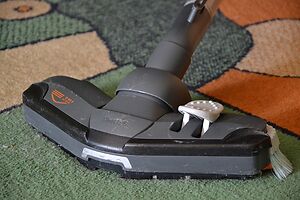 All moths love dirt. The majority of household dust is actually organic material such as dead skin, pet hair, and food crumbs, meaning a dirty carpet is a bit like an all-you-can-eat buffet for a moth caterpillar! Remember that moths will only lay their eggs in places where their young will have lots of food when they hatch, so keep your home as clean as possible to deter them.
All moths love dirt. The majority of household dust is actually organic material such as dead skin, pet hair, and food crumbs, meaning a dirty carpet is a bit like an all-you-can-eat buffet for a moth caterpillar! Remember that moths will only lay their eggs in places where their young will have lots of food when they hatch, so keep your home as clean as possible to deter them.
Seal Any Cracks in Your Home
Moths are so common that it’s impossible to keep them out of your home entirely, but you should still make it as difficult as possible for them to get in. Try and seal any cracks in your roof, walls, and skirting boards to ensure you’re as well-protected as you can be.





